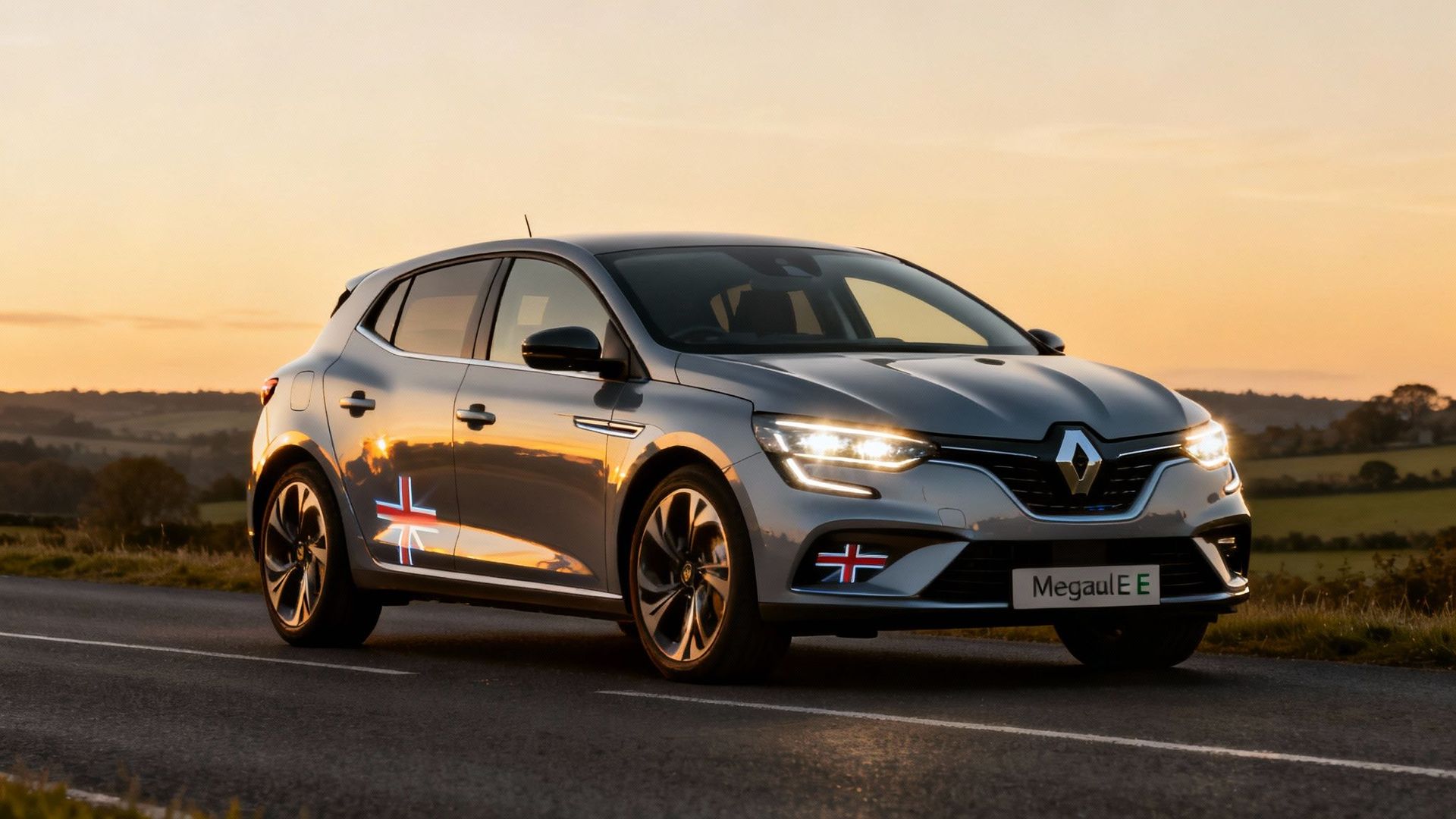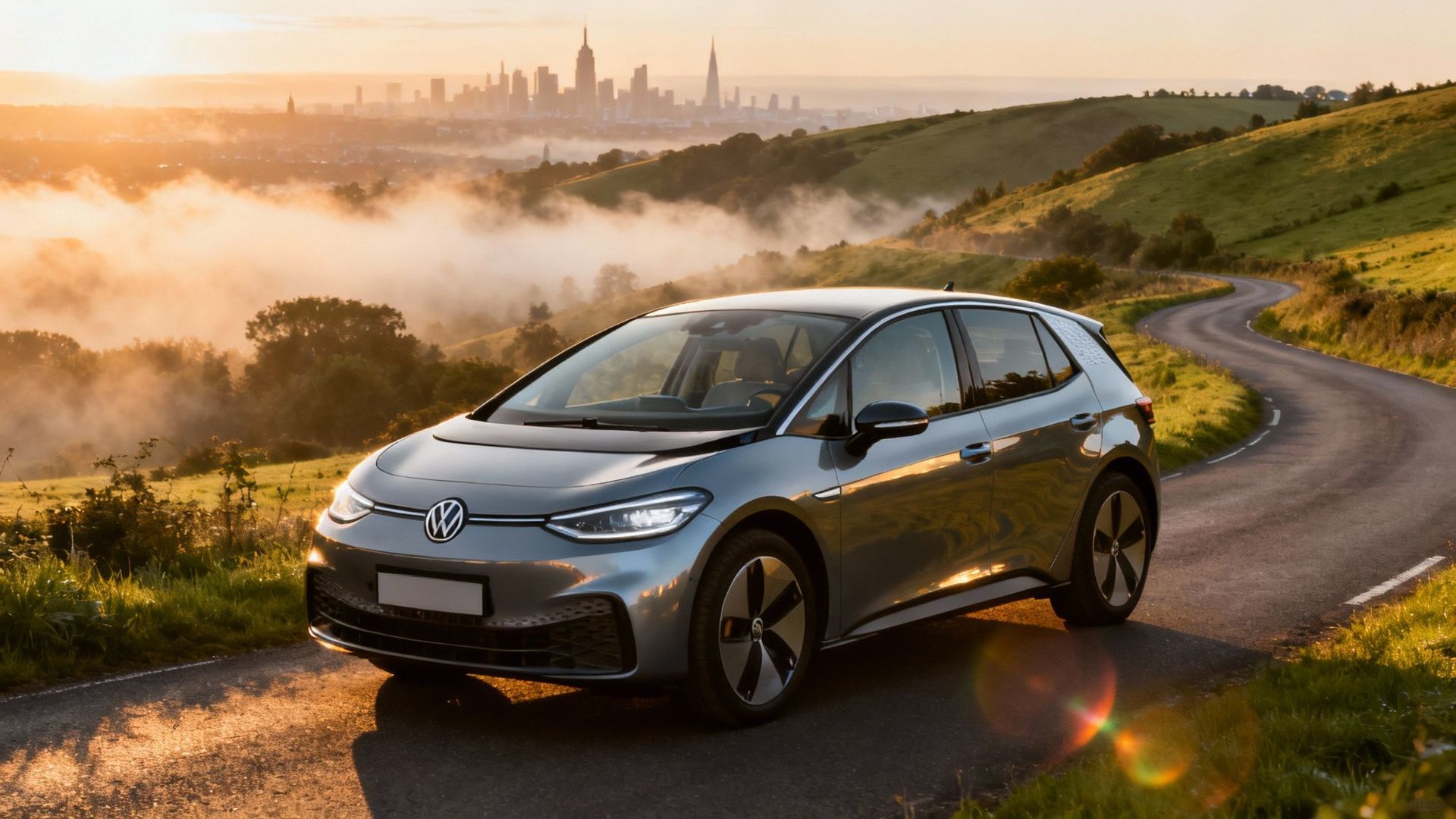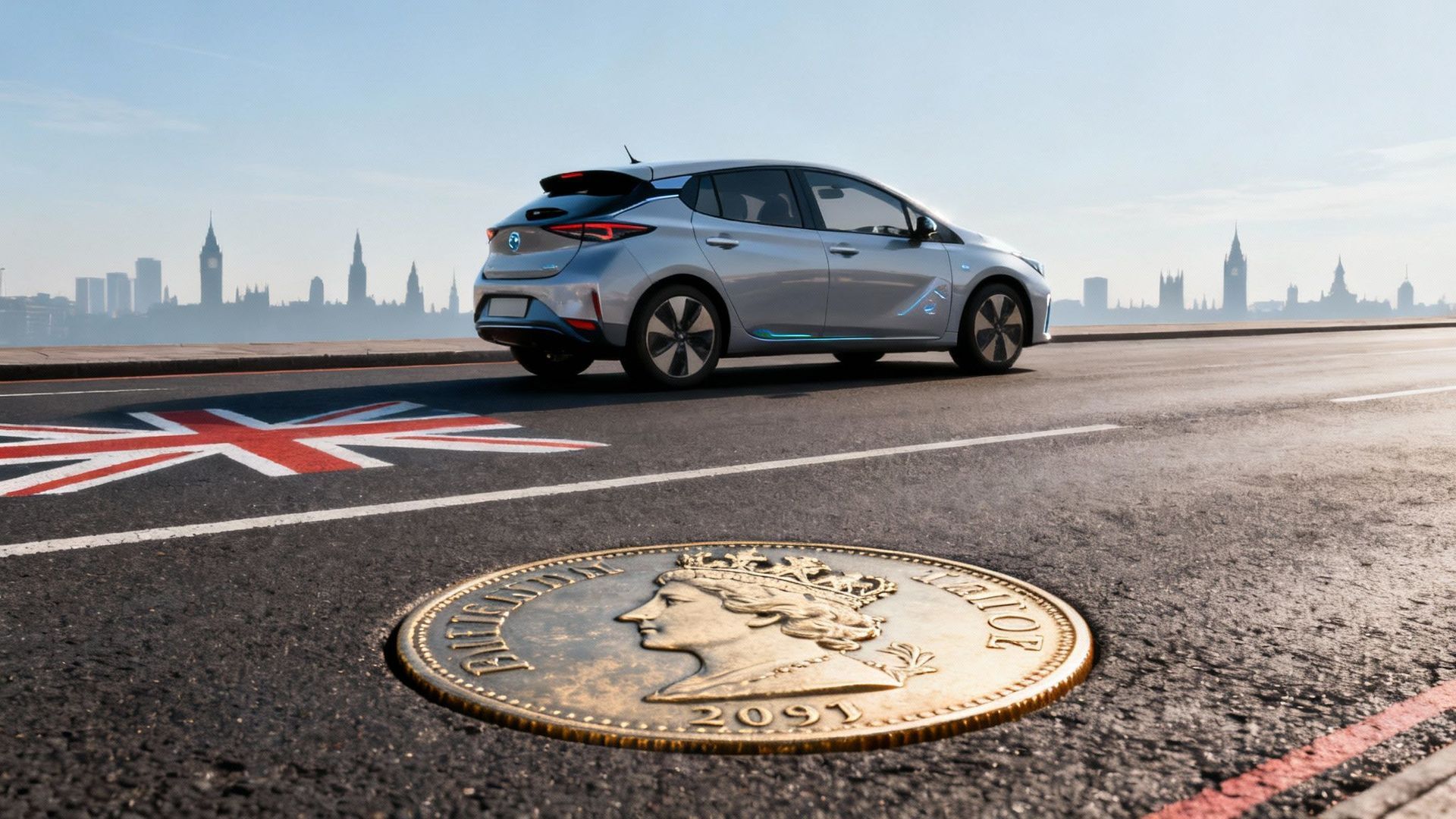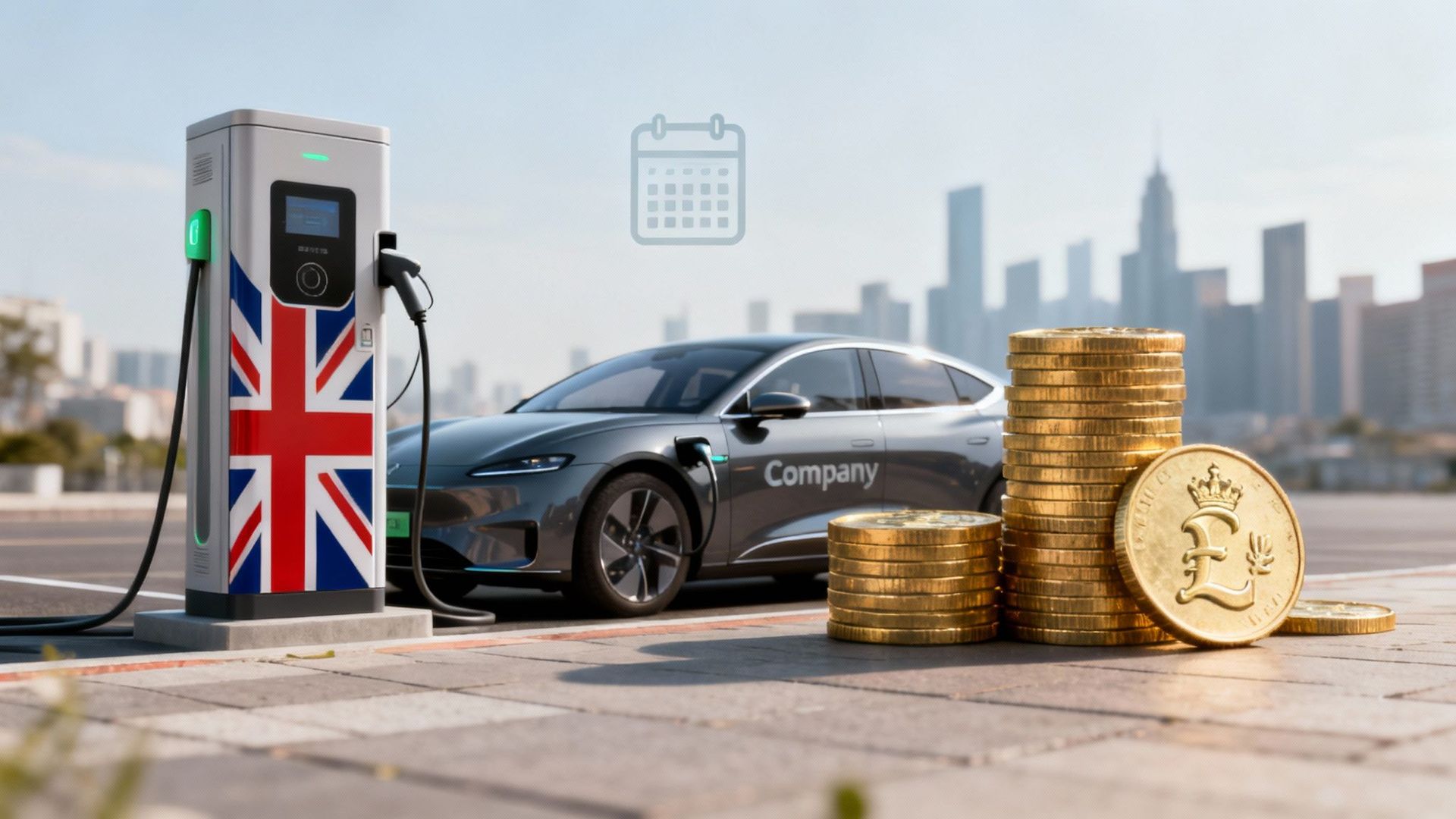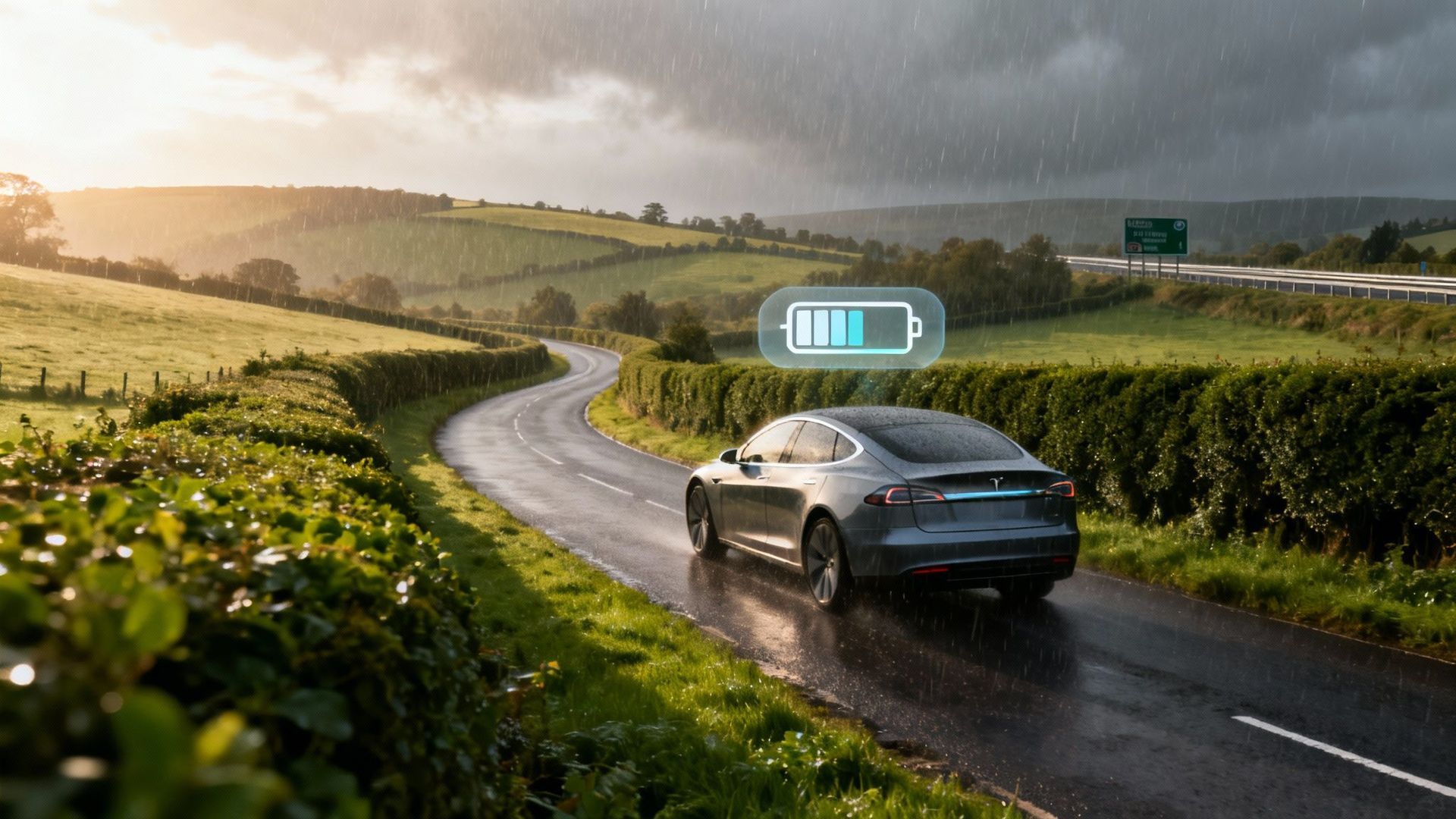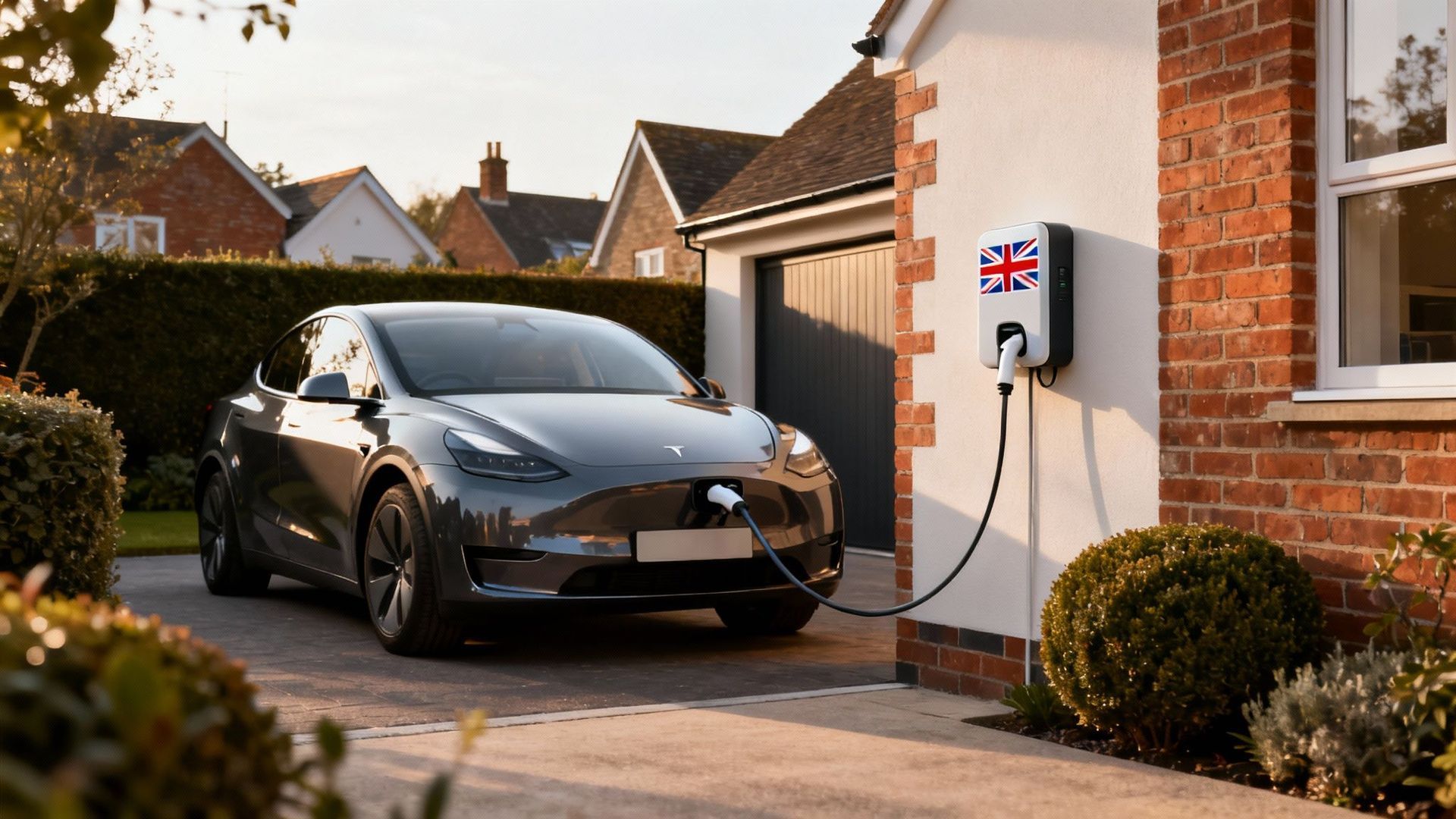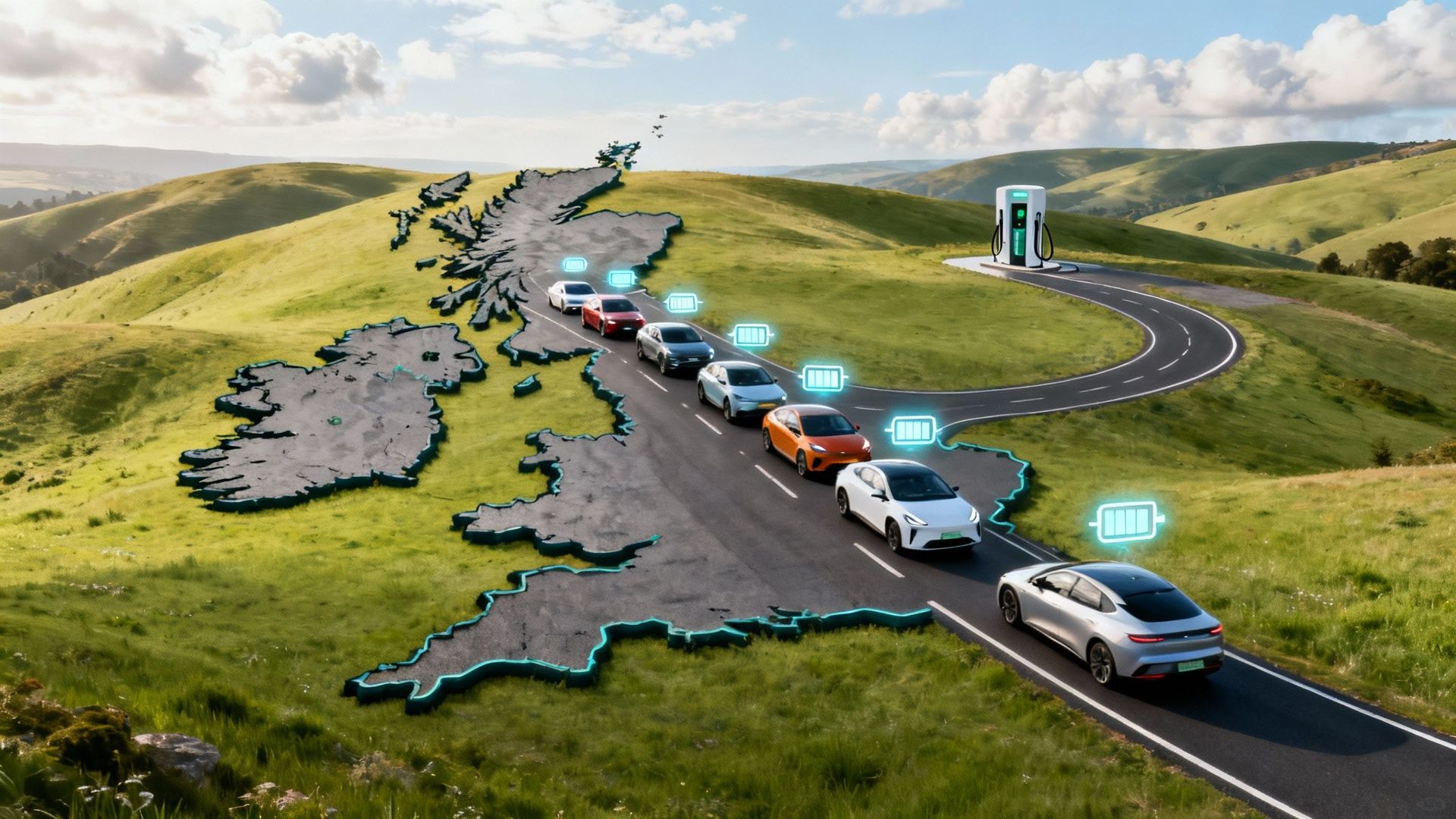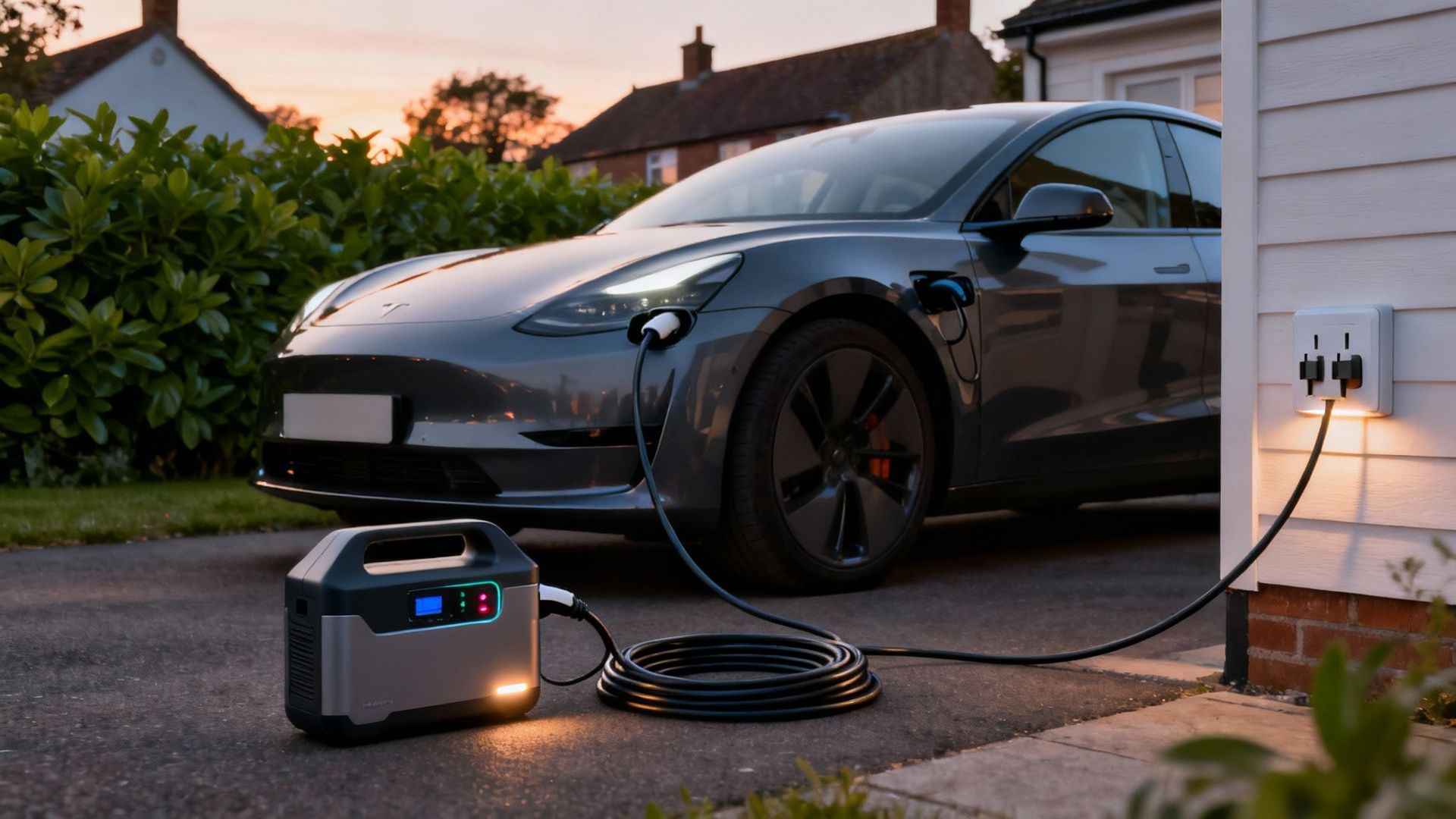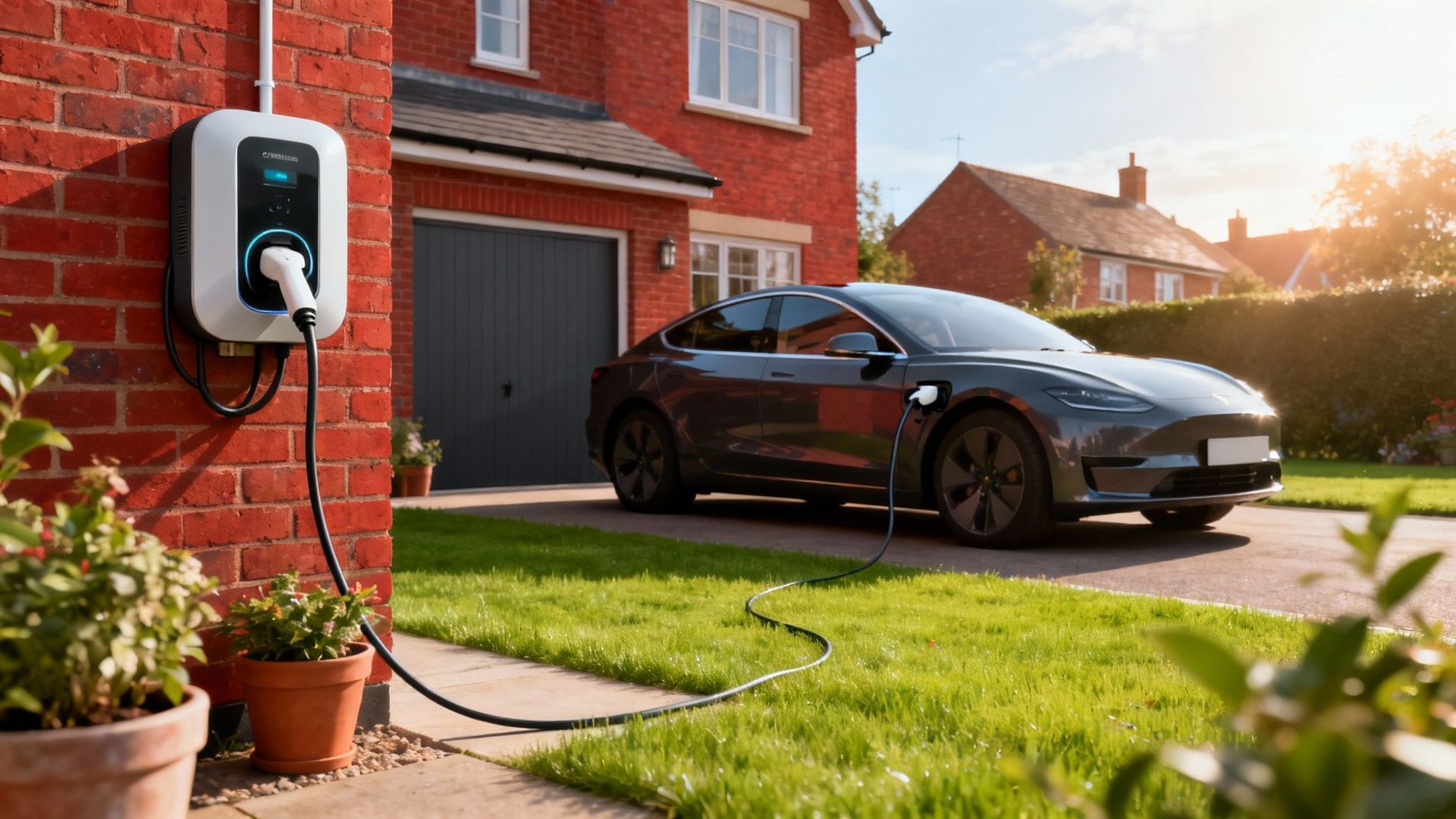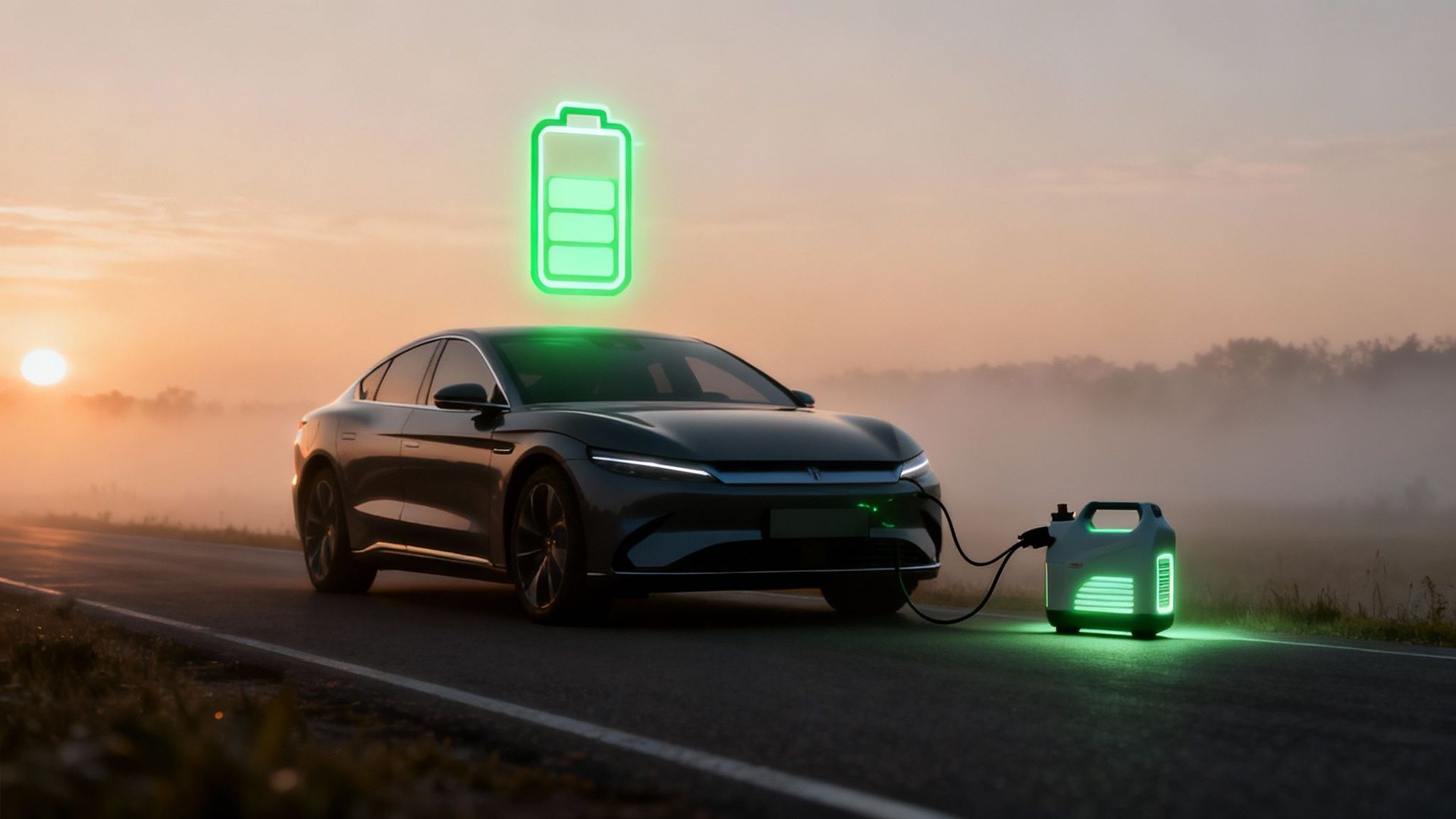Commercial EV Charging Solutions: A Sane Person's Guide to Not Messing It Up
Right then, thinking about slapping some commercial EV chargers on your business premises? Let's be brutally honest: this has shot past being a 'nice-to-have' green tick for the annual report and landed squarely in the 'commercial necessity' column for any UK business with a pulse.
This isn't just about looking virtuous anymore. It’s about future-proofing your entire operation, luring in high-value customers with electric chariots, and making sure your shiny, expensive new electric fleet doesn't become a collection of very large, very stationary paperweights.
Why Your Business Needs to Give a Toss About EV Charging

Let's cut the flannel. Ignoring the stampede towards electric vehicles is like a pub in 1995 deciding the internet was just a fad for nerds. The tide isn't just turning; it's a full-blown tsunami of battery-powered cars and vans, and businesses that fail to provide a plug will be left high, dry, and wondering where all the customers went.
This isn't some wild guess; the numbers tell a story that's impossible to ignore.
Electric vehicles made up nearly 20% of all new car sales last year. That means roughly one in every five new cars shunning the petrol station was bought right here in the UK. This trend is only getting faster, with over 1.5 million electric vehicles now silently gliding along UK roads—a tenfold increase in just the last decade.
More Than Just a Perk for Brenda in Accounts
Of course, offering workplace charging is a brilliant way to keep your team happy, especially as more of them ditch fossil fuels. It’s a real, tangible benefit that screams "we are a forward-thinking employer," or at least, "we've read a newspaper in the last five years."
But the conversation around commercial EV charging solutions has moved well beyond staff perks. For a growing number of businesses, it’s about operational survival.
- Fleet Electrification: If you run a fleet of vans or company cars, having dependable, on-site charging is utterly non-negotiable. Trying to rely solely on the public network is a logistical nightmare waiting to happen, with drivers burning valuable time hunting for available—and actually working—charge points.
- Customer Attraction and Retention: For retail, hospitality, or any business with a front door, EV chargers are a powerful magnet. An EV driver will actively choose the supermarket, hotel, or garden centre where they can top up their battery. They stay longer and, you guessed it, spend more.
Simply put, if your competitor offers charging and you don't, you're giving customers a cast-iron reason to go elsewhere. It’s becoming as essential as offering Wi-Fi or accepting card payments.
Seizing the Commercial Opportunity
Looking beyond the terror of being left behind, installing chargers opens up genuine commercial opportunities. You can set your own tariffs and create a brand-new revenue stream. What a world.
This simple move can turn a car park—traditionally just a miserable patch of tarmac that costs you money—into an asset that actively generates income. You aren't just providing a service; you're flogging electricity in a high-demand, growing market.
The potential here is significant. For a deeper dive into the numbers, you might find it useful to read our guide on the benefits of EV charging stations and why investing makes sound financial sense. This isn't just about keeping pace; it’s about getting ahead of the curve.
Decoding the EV Charger Alphabet Soup
Right, let's cut through the jargon. When you first look into EV chargers, you're hit with a barrage of acronyms: AC, DC, kW. It's enough to make anyone's head spin and long for the comforting simplicity of a petrol pump. But don't panic, it's not as complicated as it sounds.
Think of charging an EV like filling a bucket with water. You could use a slow-dripping tap, which will get the job done... eventually. Or, you could use a high-pressure fire hose and fill it in seconds. That’s the core difference between the two main types of charging.
AC vs. DC: The Steady Trickle and the Powerful Flood
Alternating Current (AC) chargers are your dripping tap. They’re the most common type you'll find at homes and many workplaces. They supply AC power from the grid, and the car's own on-board converter has to do the tedious work of changing it into the Direct Current (DC) the battery actually craves. This process is slower because it’s limited by the size of the car's internal gizmos.
DC chargers , on the other hand, are the fire hose. These are the big, brutish units you see at motorway service stations. They bypass the car's on-board converter entirely, feeding DC power directly into the battery at frankly terrifying speeds.
This image neatly lays out the hierarchy of charging options, showing how power, speed, and cost all climb together in a slightly alarming fashion.

As you can see, moving from a standard AC charger to a DC Rapid unit is a huge leap, not just in charging speed but also in the upfront wallop to your wallet.
What Do the Numbers Mean? Understanding Power Levels
A charger’s speed is measured in kilowatts (kW). More kilowatts mean a faster charge, but this also comes with higher installation complexity and eye-watering running costs. Choosing the right power level is probably the most critical decision you'll make when looking into commercial EV charging solutions .
To make this simpler, let's break down the common options you'll encounter.
A Plain English Guide to Charger Speeds and Uses
Here’s a straightforward table to help you match the charger type to your business needs, cutting through the confusing terminology.
| Charger Type | Power Level (kW) | Time to Add 100 Miles of Range | Best Use Case |
|---|---|---|---|
| Slow AC | 3kW – 7kW | 4 – 8 hours | Staff parking where cars are left all day; overnight fleet charging. |
| Fast AC | 22kW | 1.5 – 2 hours | Retail parks, supermarkets, leisure centres—places with a dwell time of 1-3 hours. |
| Rapid DC | 50kW – 99kW | 30 – 40 minutes | Public charging hubs, taxi ranks, or depots for fleets needing a quick turnaround. |
| Ultra-Rapid DC | 100kW – 350kW | 10 – 20 minutes | Motorway services and dedicated charging forecourts aiming to mimic petrol station speed. |
Ultimately, the goal is to find the sweet spot. You need a charger that's fast enough for its purpose but not so ridiculously powerful that you're paying for performance you'll never use.
Matching Charger Speed to 'Dwell Time'
The most important factor here is "dwell time" —how long will a vehicle actually be parked in the bay?
-
7kW Chargers (The All-Day Sipper): This is the workhorse of workplace charging. It’s perfect for staff who park for a full 8-hour workday . An EV can gain about 25-30 miles of range per hour , meaning a full day provides a substantial top-up. These are relatively cheap to install and rarely require major grid upgrades.
-
22kW Chargers (The Lunchtime Top-Up): A solid step up, these are still AC chargers but they pack more punch. They’re a great fit for locations where cars park for a couple of hours, like a shopping centre or a restaurant. It allows a customer to get a meaningful charge while they’re with you, making it a brilliant amenity.
-
50kW+ DC Rapid Chargers (The Quick Pit-Stop): Now you’re in the big leagues. These are DC chargers built for pure speed. A 50kW unit can add 100 miles of range in around 35 minutes . They are essential for fleet vehicles that can't afford downtime or for public charging sites where drivers expect a quick in-and-out experience.
The crucial thing to remember is that installing a 150kW ultra-rapid charger for staff who are sat at their desks for eight hours is utterly pointless. It's like using a sledgehammer to crack a nut—an eye-wateringly expensive one at that.
So, the next time someone starts throwing terms like 'fast', 'rapid', and 'ultra-rapid' at you, just ask for the kilowatt rating. That number tells you the real story.
Navigating the Planning and Installation Maze

So, you’ve picked out your shiny new chargers. It’s easy to start picturing EV drivers lining up, ready to give you their money. But let's just slam on the brakes for a moment. The journey from a pallet of boxes to a fully working charging hub is a treacherous one, paved with paperwork, potential pitfalls, and the very real risk of discovering your building’s electrical supply has the oomph of a single AA battery.
This isn't a simple plug-and-play job. Installing commercial EV charging solutions is a complex dance involving site surveys, grid capacity checks, and getting uncomfortably friendly with your local council's planning department. It’s the unglamorous but absolutely essential part of the process that separates a successful, profitable project from a row of very expensive garden ornaments.
The Site Survey: Your First, Painful Dose of Reality
Before a single shovel hits the ground, you need a professional site assessment. This is non-negotiable. A qualified electrical engineer needs to get into the nuts and bolts of your electrical system to figure out exactly what they're working with.
You might be dreaming of a bank of 150kW ultra-rapid chargers , but the reality could be that your site’s electrical supply is already straining to keep the lights and the air-con on. The survey lays bare the cold, hard facts about your available power capacity.
This first step basically dictates everything that comes next. It tells you how many chargers you can realistically install and at what power level, all without needing a hugely expensive grid upgrade. Skipping this is not just planning to fail; it's planning to fail spectacularly.
Meet Your New Best Friend: The DNO
Get ready for a new acronym in your life: DNO. This stands for Distribution Network Operator , and it’s the company responsible for the actual poles and wires that bring electricity to your premises. You need to get in touch with them, and you need to do it early.
Why? Because adding a bank of powerful EV chargers puts a massive new demand on the local grid. Your DNO has to give the green light to make sure you don’t cause a blackout for the whole street every time a Tesla plugs in.
This process is never quick. A DNO application can take months to process, so starting this conversation at the very beginning of your project is crucial. They might come back and say your current connection is perfectly adequate, or they might hit you with a quote for a grid upgrade that will make your eyes water.
Getting this information early is your best defence. Engaging with the DNO from the outset prevents any catastrophic budget surprises down the line.
The Hidden Costs of Installation
The price tag on the charger itself is just the beginning. The real financial horror story often unfolds during the installation phase, where a whole host of "extra considerations" can quickly inflate your budget.
- Trenching and Groundworks: Cables have to run from your electrical room to the parking bays. This usually means digging ruddy great trenches, which requires labour, machinery, and then making it all look pretty again.
- Grid Upgrades: As we’ve mentioned, if your DNO says you need more power from the grid, this can be one of the single biggest expenses of the entire project, often running into the tens of thousands of pounds.
- Planning Permission: Depending on the scale of your project and your local authority, you might need to apply for planning permission. This adds both time and fees to the process. Joy.
- Bay Markings and Signage: Your new charging spots need to be clearly marked out, with proper signage to guide drivers and explain how to use the chargers without having a breakdown.
This is the stage where grand plans often collide with grim reality. A thorough, detailed plan and a healthy contingency fund are your best tools for navigating these headaches. To understand how we got to this point, you can delve into the evolution of EV charging infrastructure, which gives some helpful context on today's installation challenges.
Counting the Cost and Finding Financial Lifelines
Right, let’s get down to brass tacks. You’ve waded through the different charger types and navigated the planning maze. Now for the bit that makes the finance department twitchy: how much is this all actually going to cost?
The truth is, asking "how much does an EV charger cost?" is a lot like asking "how long is a piece of string?". The final bill depends entirely on what you're trying to achieve. A single 7kW AC charger for your staff car park is one thing; a bank of 150kW ultra-rapid DC chargers needing a brand-new substation is another beast entirely.
Unpacking the Bill
The price of the charger itself is just the opening act. The real budget-busters are often lurking in the background, ready to ambush your carefully planned spreadsheet. To avoid any nasty surprises, you need to account for the whole shebang from day one.
Here's what you're really looking at:
- Hardware Costs: This is the obvious one. Prices can range from around £1,000 for a simple 7kW AC unit to well over £50,000 for a top-of-the-line ultra-rapid DC charger.
- Installation Labour: Don't forget you have to pay someone to actually fit the things. This covers everything from the electrician's time to the civil engineering work of digging trenches for cabling and making good the car park surface afterwards.
- Grid Connection Upgrade: This can be the big one. If your site needs more juice from the grid than it currently has, your Distribution Network Operator (DNO) will happily provide it… for a hefty price. This upgrade can sometimes cost more than the chargers themselves.
- Software and Management Fees: To control your chargers, set prices, and monitor usage, you'll need a management platform. This usually comes with an ongoing subscription fee, making it a recurring operational cost you need to factor in.
Thinking this through from the start is what separates a successful project from one that runs out of cash halfway through and just looks a bit sad.
Finding a Financial Lifeline with Government Grants
Thankfully, it's not all doom, gloom, and terrifying invoices. The government does, on occasion, throw some money at businesses to encourage the switch to electric. The main scheme you need to know about is run by the Office for Zero Emission Vehicles (OZEV).
The OZEV Workplace Charging Scheme is designed to soften the financial blow for small and medium-sized businesses, charities, and public sector organisations. It provides a grant that can cover up to 75% of the cost of buying and installing EV charge points, up to a maximum of £350 per socket.
You can claim for up to 40 sockets across all your sites, which adds up to a potential total saving of £14,000 . While it won't cover a massive rapid-charging hub, it makes installing a decent number of AC chargers for your staff or fleet far more palatable.
The application process can feel like a bit of a bureaucratic slog, but it's well worth the hassle. You'll need to use an OZEV-approved installer, who will typically handle the grant claim on your behalf—a real help for minimising any paperwork-induced headaches. For a more irreverent take on the whole grant-seeking adventure, you might appreciate our breakdown of the wonderfully weird world of EV subsidies.
This support is part of a much wider push. As of mid-2025, there were over 82,000 public EV charging devices available across the UK, with more than 16,000 of those being rapid chargers. This impressive growth is a direct result of coordinated efforts between bodies like OZEV and the private sector, and these grants are a key part of that strategy.
Calculating the Return on Your Investment
So, after all that spending, when do you get your money back? The Return on Investment (ROI) for commercial EV charging solutions isn't always a simple calculation, but it's very real.
The most direct route is generating revenue by setting a price per kWh for public users. If you pay, say, 30p/kWh for your electricity and charge drivers 50p/kWh , you’re making a clear profit on every single charge.
But the real value often comes from the indirect benefits. Think increased footfall from EV drivers who stay longer and spend more in your business, improved staff retention from a valuable workplace perk, and massive savings on fuel and maintenance costs for your own electric fleet. It’s an investment that pays you back in more ways than one.
Real Businesses That Got It Right (and Didn't Go Bust)

All this talk about grid capacity, grants, and return on investment is fine, but theory only gets you so far. The real question is, does this actually work out in the wild? Can an everyday business really navigate this maze without going broke or having a complete meltdown?
Let’s look at a few examples of UK businesses that have done just that. These aren’t glossy marketing stories; they’re real-world accounts of what happens when the spreadsheets meet the grim reality of digging up a car park.
The Logistics Firm That Ditched Diesel
Picture a mid-sized logistics company in the Midlands. Their problem was simple: their fleet of 30 diesel vans was becoming an expensive, polluting liability. They decided to go all-in on electric but were terrified their entire delivery operation could grind to a halt if the charging setup failed.
Instead of just plastering their depot with the fastest, priciest chargers they could find, they got smart. They took a hard look at their drivers' routes and schedules, realising the vans were parked overnight for at least 10 hours .
This simple insight changed everything. They didn't need eye-wateringly expensive rapid chargers. A bank of smart 7kW AC chargers was more than enough to get every single van back to 100% by the morning shift.
- Hardware Choice: They went for durable, network-connected 7kW units that could withstand the abuse of daily use.
- Installation: The secret sauce was load management software . This clever bit of kit automatically balances power distribution, making sure all the vans get charged without tripping the site’s main breaker.
- The Result: Fleet running costs dropped by over 60% . Even better, they could proudly advertise a zero-emission delivery service—a massive win with their increasingly eco-conscious clients.
The Boutique Hotel That Turned Plugs into Profit
Now, let’s head to a boutique hotel in the Cotswolds. They noticed a trend: more and more guests were arriving in Teslas and Polestars, asking that awkward question: "Where can I plug in?" At first, they saw it as just another expense. But then they flipped their thinking.
They installed four 22kW AC chargers in their guest car park. This was the perfect sweet spot—fast enough for a significant top-up during an overnight stay or a long lunch, but without the colossal grid connection costs of DC rapid chargers.
They didn't just give the power away for free like mugs. Using a simple management platform, they set a competitive price per kWh that covered their electricity costs and even turned a small, consistent profit. The chargers became a new revenue stream.
The real win, though, was what it did for their reputation. Their hotel shot to the top of EV-friendly travel apps and websites. Bookings from EV drivers soared, and these were often high-value customers who would happily spend money in the restaurant and spa while their car charged.
The UK's charging network is growing, but it's a real postcode lottery. As of mid-2025, there were over 84,000 public chargers , but the distribution is all over the place. Greater London has over 25,000 of them, more than double any other region. For businesses outside these urban hotspots, providing reliable commercial EV charging solutions isn't just a nice perk; it's a vital service that makes you a destination. You can dig into the numbers on the UK's regional EV charging landscape yourself.
Questions You're Too Embarrassed to Ask
Right, let's clear the air and tackle some of the questions that always come up when businesses first dip their toes into commercial EV charging. Think of this as the "no silly questions" zone—just straight-talking, practical answers.
Do I Really Need Special Software to Manage My Chargers?
In a word, yes. Unless you're happy with a car park free-for-all where anyone can plug in, for as long as they want, on your dime. That’s where a Charge Point Management System (CPMS) comes in.
This software is your control panel. It's how you set pricing, decide who gets access (staff, visitors, the general public), and keep an eye on usage. It also lets you troubleshoot problems remotely, which is a lifesaver. Honestly, trying to run a commercial charger setup without a proper CPMS is just asking for chaos. It’s an extra cost, but it’s non-negotiable if you want any control over your investment.
How Do I Figure Out How Much Power My Site Can Handle?
You don't—not by yourself, anyway. This is a job for the professionals. Before you even think about buying a single charger, you need a qualified electrician to carry out a full site survey. They'll look at your building's main electricity supply and work out how much spare capacity you realistically have to play with.
Trying to install a bank of fast chargers without doing this homework could mean you need a major grid connection upgrade, which is a lengthy and seriously expensive job. Trying to guess is a fast track to either tripping your building's power every five minutes or getting a heart-stopping bill from your Distribution Network Operator (DNO). It's not worth the risk.
Can I Actually Make a Profit From EV Chargers?
The short answer is yes, but don't plan your retirement around it just yet. Profit from commercial EV charging solutions is a bit more nuanced than just selling electricity for more than you buy it for.
You can absolutely set a price per kWh that covers your costs and turns a profit. But a smart strategy looks at the bigger picture. You have to account for the initial cost of the hardware, the installation, software subscriptions, and any maintenance down the line.
For many businesses, the real financial win isn't the direct profit from charging. It's the "amenity value." EV drivers are a valuable demographic. By offering charging, you attract them to your business, keep them there for longer, and they'll almost certainly spend more money with you while their car juices up. So yes, profit is there for the taking, but the full return on investment often comes from these powerful indirect benefits.
Ready to dive deeper into the electrifying world of EVs without the boring bits? VoltsMonster is your go-to source for honest reviews, industry news, and a bit of a laugh along the way. Join our community and get the real story on electric vehicles.

